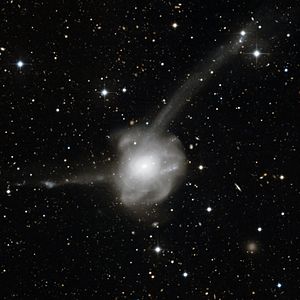NGC 7252
| Galaxy NGC 7252 |
|
|---|---|

|
|
| Image taken with the Wide Field Imager (WFI) at the La Silla Observatory | |
| AladinLite | |
| Constellation | Aquarius |
|
Position equinox : J2000.0 , epoch : J2000.0 |
|
| Right ascension | 22 h 20 m 44.7 s |
| declination | -24 ° 40 ′ 42 ″ |
| Appearance | |
| Morphological type | (R) SA (r) 0 ^ 0 ^: / HII |
| Brightness (visual) | 11.1 mag |
| Brightness (B-band) | 12.1 mag |
| Angular expansion | 2.1 ′ × 1.7 ′ |
| Position angle | 119 ° |
| Surface brightness | 12.3 mag / arcmin² |
| Physical data | |
| Affiliation | LGG 457 |
| Redshift | 0.015984 ± 0.000003 |
| Radial velocity | (4792 ± 1) km / s |
|
Stroke distance v rad / H 0 |
(217 ± 15) · 10 6 ly (66.5 ± 4.7) Mpc |
| history | |
| discovery | William Herschel |
| Discovery date | October 26, 1785 |
| Catalog names | |
| NGC 7252 • PGC 68612 • ESO 533-15 • MCG -04-52-36 • IRAS 22179-2455 • 2MASX J22204475-2440420 • SGC 221758-2455.8 • Arp 226 • GC 4780 • H III 458 • h 3934 • AM 2217- 245 • PRC D-35 | |
NGC 7252 = Arp 226 is a Lenticular Galaxy of the Hubble-type SA0 in the constellation Aquarius on the ecliptic , which is an estimated 220 million light years from the Milky Way . Halton Arp organized his catalog of unusual galaxies into groups according to purely morphological criteria. This galaxy belongs to the class of galaxies with amorphous spiral arms . The galaxy is also called Atoms for the Peace Galaxy , because it looks almost like an atom around which the electrons are orbiting. The expression comes from the 1953 Atoms for Peace speech by American President Eisenhower .
The object was discovered by William Herschel on October 26, 1785 .
The galaxy NGC 7252 imaged by the Hubble Space Telescope
Web links
- Hubble Space Telescope 1993
- Hubble Space Telescope 1997
- Capella Observatory
- SIMBAD query
- ESO: When two galaxies meet + photos, map & animations - November 10th 2010
- ESO: VLT maps the gas in the mini-coil NGC 7252 - February 5, 2018
- astronews.com: Impressive view of galactic collision November 11, 2010
- astronews.com: Picture of the day December 8, 2015
- Arp Atlas of Peculiar Galaxies
- Seligman Arp
literature
- Jeff Kanipe and Dennis Webb: The Arp Atlas of Peculiar Galaxies - A Chronicle and Observer's Guide , Richmond 2006, ISBN 978-0-943396-76-7

